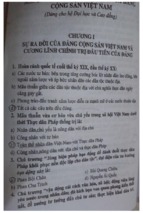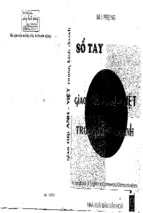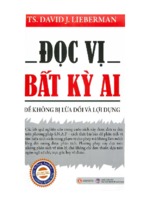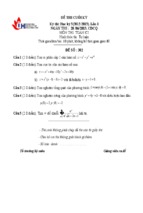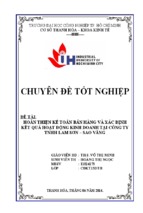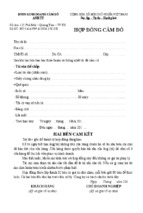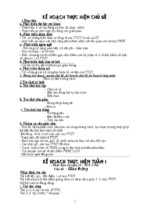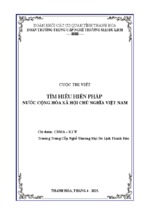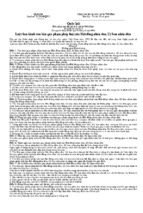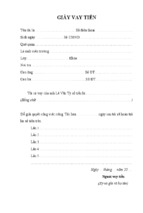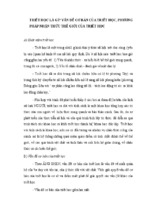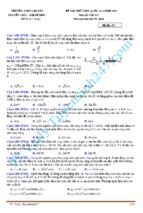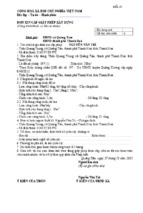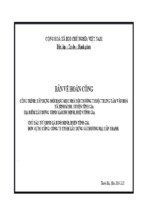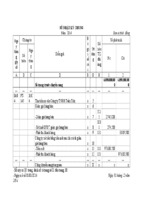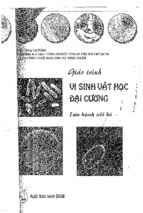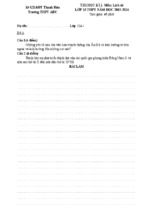MINISTRY OF EDUCATION AND TRAINING
2019 – 2021(2)
HANOI OPEN UNIVERSITY
ENGLISH LANGUAGE
M.A. THESIS
GIVING AND RESPONDING TO
COMPLIMENTS IN ENGLISH IN VALIDATION AND
THE DEVIL WEARS PRADA
(Nghiên cứu cách khen và đáp lại lời khen bằng tiếng Anh trong
phim Validation và The devil wears Prada)
MAI THI THU DONG
MAI THỊ THU DONG
Field: English Language
Code: 8.22.02.01
HANOI – 2021
MINISTRY OF EDUCATION AND TRAINING
HANOI OPEN UNIVERSITY
M.A. THESIS
GIVING AND RESPONDING TO
COMPLIMENTS IN ENGLISH IN VALIDATION
AND THE DEVIL WEARS PRADA
(Nghiên cứu cách khen và đáp lại lời khen bằng tiếng Anh trong
phim Validation và The devil wears Prada)
MAI THI THU DONG
Field: English Language
Code: 8.22.02.01
SUPERVISOR: DR. TRAN THI LE DUNG
HANOI – 2021
CERTIFICATE OF ORIGINALITY
I, the undersigned, hereby certify my authority of the study project report entitled
“Giving and responding to compliments in English in Validation and The devil
wears Prada” submitted in partial fulfillment of the requirements for the degree of
Master in English Language. Except where the reference is indicated, no other
person’s work has been used without due acknowledgement in the text of the thesis.
Hanoi, 2021
Mai Thi Thu Dong
Approved by
SUPERVISOR
Date: 10/01/2022
i
ACKNOWLEDGEMENTS
It has been a long journey for me to finish my thesis. There are also many
people who walked along with me to support and motivate me during the time of
doing the research.
First and foremost, I would like to express my sincere gratitude to Ms. Tran
Thi Le Dung, Ph. D., my supervisor, who has patiently and constantly supported me
through the stages of the study, and whose stimulating ideas, expertise, and
suggestions have inspired me greatly through my growth as an academic researcher.
My thanks also go to all my lecturers at Hanoi Open University for their
precious knowledge which lay the foundation for this study, my colleagues and
many others whose support and encouragement help me to have this thesis
accomplished.
Last but not least, I am greatly indebted to my family and friends for their
patience, endless love, and devotion. Whatever choices I have made, they have
always stood by me and believed in me. I am immensely thankful for all the
assistance they have given to me.
ii
ABSTRACT
Every human living in this world is created as a social creature. He/she always
needs other people in his/her society to fulfill his/her social needs. In order to meet
his/her social needs as a social creature, people have to be able to communicate or
interact with the society. To communicate, people need language which is one of
tools of communication. The use of language can be found in conversations. Thus,
conversation is a real form of language uses. It is an exchange of words, sentences
and many other expressions that happen when two or more people are involved in
talking about a certain thing in a certain situation. There are some many studies of
famous theorists on kinds of speech act such as: making request, asking for
permission, giving apology.... but not many of them focus on speech act of
compliments. This is also the interesting topic attracting the author’s interest
because it requires a great deal of pragmatic insight by speakers and therefore are
often rich with data that reveal the orientation of language learners. Moreover,
responding to compliments is vital to everyday communication. In this study, the
author would like to investigate the way people give and respond to compliments
in English by analyzing compliments and their responses in two films named
Validation and The devil wears Prada. Strategies and some implications of giving
and responding to compliments in English are concluded in the findings so that
English learners and users may have a trustful material to study and use for their
daily communications.
iii
LIST OF ABBREVIATIONS
AR: Addresser
AE: Addressee
FTA: Face Threatening Act
H:
Hearer
PS:
Politeness Strategy
S:
Speaker
UC: Unknown Character
iv
LIST OF TABLES
Table 1
10
Table 2
Table 3
Table 4
19
63
64
Table 5
Table 6
Table 7
Table 8
64
65
67
70
v
TABLE OF CONTENTS
Certificate of originality
i
Acknowledgements
ii
Abstract
List of abbreviations
iii
iv
List of tables
v
Table of contents
vi
Chapter 1: INTRODUCTION
1.1 Rationale
1
1
1.2 Aims and objectives of the study
2
1.3. Research questions
1.4. Methodology of the study
3
3
1.5. Scope of the study
1.6. Significance of the study
5
5
1.7. Structure of the study
Chapter 2: LITERATURE REVIEW
2.1. Previous studies
5
7
7
2.1.1 Previous studies in English
2.1.2 Previous studies in Vietnamese
2.2 Review of theoretical background
2.2.1. Definition of Pragmatics.
2.2.2. Overview of Speech Acts
2.2.2.1. Definition of speech acts
2.2.2.2. Components of Speech acts
2.2.2.3. Classifications of Speech acts
2.2.3. Kinesics
2.2.3.1. Body language
2.2.3.2. Smiles
2.2.3.3. Eye contact
8
8
8
8
9
9
10
10
11
11
12
12
2.2.3.4 Touching
2.2.4. Politeness theory
2.2.4.1. Positive Politeness Strategies
2.2.4.2. Negative Politeness Strategies
12
12
13
16
vi
2.2.5. Compliments and Compliments’ Responses
2.2.5.1 Compliments
2.2.5.2. Topics of compliments
17
17
18
2.2.5.3. Compliments’ responses
2.2.6. Films
2.2.6.1. Synopsis of the Film Validation
21
21
2.2.6.2. Synopsis of the Film The devil wears Prada
22
2.3. Summary
23
Chapter
3:
ANALYSIS
AND
SOME
IMPLICATIONS
OF24
COMPLIMENTS AND COMPLIMENTS’ RESPONSES IN THE FILMS
VALIDATION AND THE DEVIL WEARS PRADA
3.1 Analysis compliments and compliments’ responses of the Validation and The24
devil wears Prada
3.1.1. Analysis of Validation
3.1.2. Analysis of The devil wears Prada
24
43
3.1.3. Summary
3.2 Topics of compliments
3.2.1. Compliments on appearance
62
62
62
3.2.2. Compliments on skills or talents
63
3.2.3. Compliments on work accomplished or dedication
64
3.2.4. Compliments on possession
65
3.2.5. Summary
65
3.3. Giving compliment strategies and their response strategies
67
3.3.1. Politeness strategies in Validation
67
3.3.2. Politeness strategies in The devil wears Prada
70
3.3.3. Compliments
71
3.3.4. Compliment responses
72
3.3.4.1. Positive Politeness
73
3.3.4.2. Negative Politeness
74
3.4 Some implications for English learners when giving and responding to 74
compliments in English
3.4.1 What to compliment on
3.4.2 .How to give a compliment
3.4.3. How to respond to compliment
74
74
75
77
vii
3.4.4. Top compliment formulas
Chapter 4: CONCLUSION
4.1. Recapitulation
77
79
79
4.2. Concluding remarks
79
4.3. Limitation of the research
4.4. Recommendations and suggestion for further studies
81
82
REFERENCES
83
APPENDIX
85
viii
CHAPTER 1: INTRODUCTION
1.1. Rationale
Mankind needs to interact and communicate with others in their daily life.
One of the most important tools for the communication required is language.
Language is a vital tool to show what people feel and think, including spoken or
silent language. When people communicate with others, they can know how
successful their communication is. The communication is considered successful
when the speaker is aware of what the meaning of utterances and the hearer is able
to understand the intended meaning of speakers. However, when someone says
something to another one, the one performs not only the certain purpose but also the
act. The realization of act in certain social communication is called speech act.
Speech act includes apologies, requests, complaints, compliments and
responses to compliment. Holmes (in Paulson and Tucker, 2003) stated compliment
as a speech act which explicitly or implicitly points out from the one to someone
else. Someone usually praises the others for their good things; such as appearance,
character and skills... In addition, Holmes (in Paulson and Tucker, 2003) announced
that the main function of a compliment is affective and social rather than referential
or informative. It explains that the reasons of misunderstanding and
miscommunication failure as there are different norms of complimenting and
responding to compliments.
Compliment represents a social strategy in which the speaker tries to create
good relationship with the hearer by expressing admiration or approval (Wolfson &
Judd, 1983). Compliments are to make the one who is praised feels good. For
example, two friends meet and one delivers a compliment: “Your hairstyle is
great”. These simple expressions of compliments can create good feeling between
them.
Compliment itself has many forms, it is important for people to know on what
topics people could deliver compliment. Wolfson in Wolfson and Judd (1983) said
that what members of particular cultural group thank or apologize for, or
compliment on, usually reflects values, as in performing these speech acts, people
are often implicitly assessing the behavior, possessions, accomplishment, character,
or appearance. Therefore, specific relationship between the speaker and the hearer
also affects the choice of type of compliment considered appropriately. In other
words, there is a basic or reason for the people to deliver compliment, it may be
based on the appearance, possessions, skills, talents etc.
1
Film is a kind of source of data because it is a representation of real life.
Allen and Gomery (1993) declared that the story of the film is a social phenomenon
that shows the real life. The movie is considered as a life-image that is acted by the
actors and actresses on the screen. Mostly, the story of the films is often taken from
reality including the conversation. This study explores two American films since the
films have the richness of data containing compliments and their responses.
Validation and The devil wears Prada are films which are meaningful to watch. The
sentences in general, the compliments in particular used are not too long and
easy to be employed in everyday speaking.
A study about compliment has been investigated by Choironi (2013) in her
thesis named “Compliment Responses on Facebook Status Used by Foreigners:
Gender Perspective.” She used Sociolinguistics approach as the way of the
analysis. This research aimed to describe the distribution of the difference between
male and female in giving compliment responses on Facebook status.
From the study above, the author would like to understand deeply about
compliments and their responses in the movies named Validation and The devil
wears Prada that were published in 2007 and 2006 respectively. It is exciting to
investigate the varieties of giving and responding compliments that occur in the
society which is represented in films. Having different scope of linguistic from the
previous study, the writer uses a Pragmatic approach as the scope of the study anh
has chosen the topic “Giving and responding to compliments in English in
Validation and The devil wears Prada” with the expectation of finding out the main
topics of compliments and strategies that can be used when giving and responding
to compliments in English through two famous American films: Validation (2007)
and The devil wears Prada (2006).
1.2. Aims and objectives of the study
1.2.1. Aims of the study
The study is conducted to help Vietnamese learners of English give and
respond to compliments in English correctly and effectively.
1.2.2. Objectives of the study
To achieve the aims above, the following objectives can be put forward:
- To identify topics that the native speakers of English often compliment on the
films Validation and The devil wears Prada.
- To find out strategies of giving and responding to compliments in English on
the films Validation and The devil wears Prada.
2
- To give Vietnamese learners of English some implications of using topics and
strategies in giving and responding to compliments in English effectively.
1.3. Research questions
This study intends to answer the following questions:
1.
What do the native speakers of English often compliment in the films
Validation and The devil wears Prada?
2.
What are strategies of giving and responding to compliments in English in
the films Validation and The devil wears Prada?
1.4. Methodology of the study
The methods used in this study include:
Research approach.
The main aim of the study is to help Vietnamese learners of English give and
respond to compliments in English correctly and effectively through pointing out
main topics of compliments and strategies of giving and responding to compliments
in English in two mentioned films. Therefore, to achieve the aims stated,
quantitative and qualitative methods were applied in the study, which are mainly
used to analyze compliments and their responses in the films.
Major methods and supporting methods
Describing and analyzing the compliment categories in English in two films
The main method employed in this study is the descriptive method with quantitative
and qualitative approach. Quantitative method can involve collecting quantitative
information, involves gathering mass of raw data from different powerful sources.
Qualitative method is used to describe and interpret the main features of English
compliments and their responses.
Analytical methods assist to the major method in this study. Analytical
method will be used to analyze compliments that are available after carrying out the
descriptive research.
Data collection techniques
For achieving the aims and objectives of the study with high reliability, two
data collection techniques have been employed: selecting materials and collecting
compliments and their responses from the two mentioned films.
Data analysis techniques.
The selected materials related to compliment categories in English played an
important role in terms of supplement data for the study. In order to identify
compliments and their responses, the author collected the data from two films called
3
Validation and The devil wears Prada. After that, the author describes, analyses and
gives out the compliments’ topics and their strategies, as well as some implications
for Vietnamese learners of giving compliments and their responses.
Furthermore, Google search engine was used to select materials. Up to now, it has
become the most popular and effective ways to find reliable and diverse sources of
materials.
From the films, data are gathered and all of them are then taken and
analyzed.
Data coding:
In this research, the data coding is done in order to make the analysis of each datum
easier to understand. The data coding is based on the order of the datum number.
The number of data is as follows:
V or D (V for Validation, D for The devil wears Prada)
The number of each datum.
The time when the compliment occurs.
The following example is given to make it clear.
V03/00:30:06
It means that the datum is from the film Validation with number 03. The
compliment occurs in the hour of zero, minute of 30 and 6 second.
D01/00:20:06
It means that the datum is from the film The devil wears Prada with number 01.
The compliment occurs in the hour of zero, minute of 20 and 6 second.
Technique of Analyzing Data
In analyzing the collected data, some steps are conducted as follows:
* Giving mark on compliments and their responses in the dialogues
(Utterances typed bold are compliments, while the underlined
utterances are compliments responses).
*Analyzing the compliments’ topics, their responses and the politeness
strategies applied by the speakers in delivering the compliments and the
compliment responses by applying Brown and Levinson’s theory of
politeness strategies and Herbert’s theory of compliments responses
strategy.
*Classifying all the utterances of compliments, the compliment
responses, and politeness strategies found in data analysis into a unit of
discussion.
4
The analysis is arranged as follows:
Data description
It shows the dialogue between participants containing the compliments and
their responses.
Description of context
This part presents the context of communication, the participants of the
conversation, and the relationship between participants.
Data analysis
The analysis describes the way characters deliver compliments and the
responses given by the hearer are discussed. Then, topics of compliments are also
stated. Chaika’s theory of kinesics are used in analyzing the data. In addition, it
also describes the analysis of the responses to the compliment from the addressee
based on Herbert’s theory of compliment responses. Meanwhile, Brown and
Levinson’s politeness theory used to analyze the politeness strategies is applied by
the participants in delivering the compliments and in responding to the
compliments.
1.5. Scope of the study
- The data used in the study are collected from 2 films called Validation
(2007) by Kurt Kuenne and The devil wears Prada (2006) by David Frankel.
- The study only investigates compliments’ topics and strategies employed in
the films Validation and The devil wears Prada
- The information of giving and responding to compliments in English is also
collected from the internet, M.A thesis, book…
- The study only deals with topics of compliments and strategies given when
speakers give and respond to compliments.
1.6. Significance of the study
Theoretically, major topics of compliments in English in Validation and The
devil wears Prada are highlighted and analyzed in great detail to add some certain
theoretical background to study English.
Practically, the findings of the study will help users of English in general and
Vietnamese users in particular guarantee successful communication when using
compliments in English. As a teacher of English, the author feels duty-bound to
raise her students’ awareness of conventional behaviors in common situations.
1.7. Structural organization of the study
5
The thesis consists of 4 chapters as follow:
Chapter 1 is the Introduction of the study which shows the reasons why the
topic is chosen, what the research aims at as well as the scope, the significance and
the structural organization of the study
Chapter 2 is the Literature review and Theoretical background of the study.
This chapter will give the brief review of related literature and theoretical
background of every matter mentioned in the study.
Chapter 3 is the Findings and Discussions. In this chapter, it presents and
analyzes the collected data from clues in two films Validation and The devil wears
Prada as well as gives the main topics of compliments in the two films. Besides
that, the study offers some implications for Vietnamese learners of English in
giving and responding to compliments in English.
Chapter 4 is the Conclusion of the study which presents the recapitulation of
the study, the limitations of the study and some suggestions for further study.
6
CHAPTER 2: LITERATURE REVIEW
2.1. Previous studies
2.1.1. Previous studies in English
Johnson (1979) says that in English speaking cultures, accepting a
compliment by saying a single “Thank you” may be enough and at the same time
regarded as the most adequate response.
However, Pomerantz (1978) proclaims that this might not be the case in the
American English setting. Her theory shows two conflicting principles that put
pressure on an addressee when she /he is going to give a response to a compliment
delivered. She guides that in any conversation, it is preferable to avoid disagreement
and as such, a good compliment response should be one of acceptance and
agreement. However, a response of this kind would correspond with one’s
expression of self-praise, which may be considered negative by the compliment
giver.
Based on two common principles of Pomerantz (1978), Herbert (1986)
showed three categories of compliment responses: Agreement, Non-agreement, and
other interpretations.
Manes and Wolfson (1981) analyzed 686 compliments using an
ethnographic method. The researchers noted down on a notebook the compliments
that they are used in daily life and they also asked the help of research assistants to
collect data. They concluded that in American English, compliment as a speech act
is highly formulaic on the syntactic and semantic levels in that three patterns are
sufficient to account for 85% of the syntactic structure of the whole data and that
two thirds of all the adjectival compliments make use of only five adjectives.
Holmes (1986) reproduced Manes and Wolfson’s (1981) study and a datum
of 517 compliments in New Zealand English was gathered using an ethnographic
method. The number of syntactic patterns occurring regularly is high. The formulaic
features of compliment were confirmed in this variety of English. The three most
frequent syntactic patterns reported by Manes and Wolfson account for 70% of
Holmes’ New Zealand data. Six adjectives were used with high frequency and
accounted for about two thirds of all the adjectives used. However, Holmes also
noted the occurrence of the distinctively New Zealand syntactic variants.
Mojica (2002) analyzed 270 compliments ethnographically with the assistance of
students. Her research agenda is to find out how Philippine college students give
and respond to compliments using Filipino language. Mojica concluded that
7
Filipino compliments were formulaic in nature in that a limited set of syntactic
patterns and some positively-valued adjectives were frequently used to give
compliments.
Herbert, R.K. (1989) built a collection of compliments and compliment
responses from 40 American feature films and compared with the research results
reported by Manes and Wolfson (1981). He discovers that the film data is in
correspondent fairly closely with the naturally-occurring data from the pragmalinguistic perspective, even though not so in terms of socio-pragmatics. The overall
distribution of syntactic patterns in compliments is the same to the one reported by
Manes and Wolfson. Jucker (2009)- the philological researcher collects data from
fictional material, such as short stories, novels and movies, after that takes note of
all the compliments and compliment responses that can be found.
2.1.2. Previous studies in Vietnamese
Loan, Nguyen (2010) in “A Vietnamese-English Cross- Cultural Study of
Positive Politeness and Negative Politeness in Complimenting” shows the use of
Positive Politeness and Negative Politeness strategies in complimenting by English
native speakers and Vietnamese ones.
Canh, Truong (2010) in “Giving and Receiving Compliments-A CrossCultural Study in English and Vietnamese” studies how people give and receive
compliments in Australian English and in Vietnamese.
In “Về cách thức khen và tiếp nhận lời khen trong phát ngôn Việt-Mỹ”, Kieu
Oanh Ho (2000) did a research on complimenting and responding compliments
between the Vietnamese and American.
In short, the above studies investigate compliments and compliments’
responses, but they only focus on cultural differences in English and Vietnamese or
other languages. In this study, the author would like to investigate English
compliments and their responses through two films Validation and The evil wears
Prada and suggest ways of giving and responding to compliments in English in
detail.
2.2. Review of theoretical background
2.2.1. Definition of Pragmatics.
Pragmatics is one of the branches of linguistic study which focuses on
meaning utterances. Leech (1983) stated that pragmatics can be defined as the study
of how the utterances have meaning in certain situation. It means that Pragmatics is
8
concerned with the meaning of utterance which the meaning depends on the
situation where the utterance happens.
According to Yule (2006), Pragmatics is the study of contextual meaning.
This kind of study necessary involves the interpretation of what the speaker means
in particular context and how the context influences what is said. It also relates to a
consideration of how the speaker organizes what she or he will like to say in
appropriate way to someone else, where, when and what the circumstances the
speech act takes place.
Based on the definitions above, it can be concluded that Pragmatics is a
study which discusses a meaning of language by concerning the relation between
language and context. It means that the interaction between the context and
language becomes the main focus in Pragmatic.
2.2.2. Overview of speech acts
2.2.2.1. Definition of speech acts
The British philosopher Austin (1962) was the first one to define the term
“speech acts” and its theory, then “speech acts” were further developed by other
theorists; such as Searle (1969, 1976), Leach (1983), Levinson (1983), Yule
(1996,1997). They all agree that there is a close connect between speech acts and
language functions.
Austin (1962) describes many functions performed by utterances as part of
interpersonal communication. Moreover, he shows that many utterances do not
contain information, yet are similar to actions. They are “words that do things” in
the world and in saying something the speaker does something. Besides, Austin
(1960) firstly used the norm “speech acts to refer to an utterance” and the “total
situation in which the utterance is issued”.
Sharing with Austin’s ideas, Richards, Platt, J. and Platt, H. (1992) defines,
“speech acts is an utterance as a functional unit in communication”. Also, Yule
(1996) states, “Actions performed via utterances are generally called speech acts”.
These speech acts are commonly given such specific labels as apologizing,
complaining, complimenting, inviting, promising or requesting etc.
Thus, their common assumption is that when conversing people use
grammatical and lexical units not only to produce utterances, but also to perform
9
actions. These speech acts, considered as minimal units of human communication,
are performed in actual situations of language use – as Searle (1969) says, “….
Speech acts…are the basic or minimal units of linguistic communication”.
2.2.2.2. Components of Speech acts
According to Austin’s theory (1962), the act is performed under any of the
three forces; what we say has three kinds of meaning called three components;
namely, locutionary, illocutionary, and perlocutionary.
Locutionary Force: is what produces the act of “saying
something”, i.e., the act of uttering a certain sentence with a meaning.
Illocutionary Force: In performing a locutionary act, we may also
perform such an act as questioning, promising, warning, ordering, etc. Thus, the
words have the force of a question a promising, a warning, an ordering, etc. Austin
made a distinction between a locutionary act and an illocutionary act as one
between the act of saying and the act in saying something, respectively. The latter is
the inherent function of the speech act, which might be established by simply
looking at the act itself in relation to existing belief. For example, “I’ll help you”
could be considered to be a promise if one believed that the hearer would be pleased
at the news.
Perlocutionary Force: is one that produces the consequential effects
on the speaker or hearer’s feelings, thoughts or actions. For example, the acts of
coming of the speaker and the expectation of the hearer for the speaker to come will
be the effects of the promise “I’ll come”.
2.2.2.3. Classifications of Speech Act
There are various kinds of speech acts; however, John Searle (1976)
classifies them into five main types, which is highly appreciated.
Table 1: Classifications of Speech Act
1
2
Explanation
Paradigm cases
Example
Representatives - commit a speaker to - asserting, stating, - I am a good
the truth of an concluding, boasting, doctor
expressed
describing,
- Bao was an
proposition
suggesting
accountant.
Commissives
-commit a speaker to promising, - I'll see you
some future action pledging,
tonight.
threatening, vowing, - I will kill you.
offering
10
- Xem thêm -


